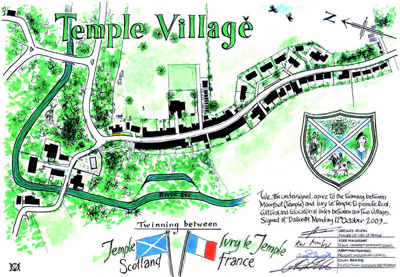Ivry-le-Temple Bulletin: 2009
You can download a PDF of this article in French.

Following a request for a twinning from a village called “Temple”, former fiefdom of the Templars in Scotland, Kerr MacGregor, President of Moorfoot Community Council in Scotland and Margaret Munro, the Secretary were received in Ivry on 17 August (2009).
In the evening of their arrival, at a small reception, a poster, created by J – M Masson,with the flag of our two countries, was presented to them.
On Tuesday the 18th, we arranged a visit to the village for our new friends. On Wednesday morning we visited the Cathedral of Beauvais where Kerr was photographed and interviewed by a journalist who was intrigued by the kilt of our Scottish friend!!!
Interest in the twinning having been established by both parties, it was decided that we in turn would visit their village. And so, on the 12 th of October (2009) a delegation from Ivry consisting of the Mayor Jacques Leclerc, the deputy Catherine Herman, and myself, set off from Beauvais, destination Glasgow!
Kerr drove us to Temple, which is near Edinburgh. During the journey of two and a half hours we were able to appreciate the landscapes of this part of the South of Scotland. We were surprised to find out that open-cast coal mining was one of the resources of this region. Temple is in Midlothian; a green region of farmland, and hills where wind turbines have sprung up. The Moorfoot hills which separate Midlothian from Edinburgh have no fewer that 60!
The same evening in Dalkeith, we attended an official reception in the headquarters of Midlothian Council, the equivalent of our “Conseil Général“. The Vice-President and other representatives of the region greeted us for an official twinning ceremony during which Jaques and Kerr signed the twinning charter.
The next day, we visited the village and surrounding area –
“Temple old church” – The old church in Temple was built in the 14th century by the Templars, and has suffered from the effects of the years, but still retains much of the original. It is surrounded by a cemetery that contains interesting tombstones.
“Rosslyn Chapel” – on to Roslin, built in the 15th century this is one of the most beautiful and most historic of all of the churches in Scotland It is recognised around the world for its numerous and famous sculptures, such as “the Green Man”, which is found in more than one hundred examples in the site. John Ritchie, who guided us on the tour, is the curator and co-author of a book on this chapel, and is also a Knight! Note: Temple and Rosslyn Chapel are mentioned in the book “Da Vinci code”.
“Moorfoot school”: The village school was closed down in recent years, and it is to a beautiful all modern school that the children of the village are now taken every day by coach. We visited the various classes, shared a few words with the teachers and students, and responded to their questions. It should be noted that in Scotland, the study of French starts at the beginning of primary school; This is a fantastic opportunity for linguistic and cultural exchange between residents of our two villages, which is especially in the interests of the children in our schools.
“Borthwick Castle” – An impressive and unspoilt castle where Mary Queen of Scots spent her last days of freedom in 1567. We can still admire the bed where she slept.
“Glenkinchie Distillery” – which produces an excellent “single malt” whisky
In the evening, a “Ceilidh” was organised in Temple in our honour. To the sounds of the band “the Shandoneers”, we were introduced to Scottish dancing. We sampled scottish cheese accompanied by French wine. That evening, our host John prepared “the haggis” for us, a Scottish specialty, the rumen of stuffed sheep(?); It is served accompanied by a ceremony!
The next day, Kerr took us to visit “Arniston House”. A magnificent residence located in the heart of an immense private park restored by the Dundas family who have been the owners since 1571. The hall offers us a splendid low angle view of the different floors. An impressive number of “tableaux” cover most of the walls.
Kerr then returned us to Glasgow Airport.
Now that the first steps have been taken, we must form a twinning Committee and arrange to meet up with our friends “d’Outre-Manche“All proposals will be welcome, as well as good wishes…
Jacques Cattin, Twinning project.
